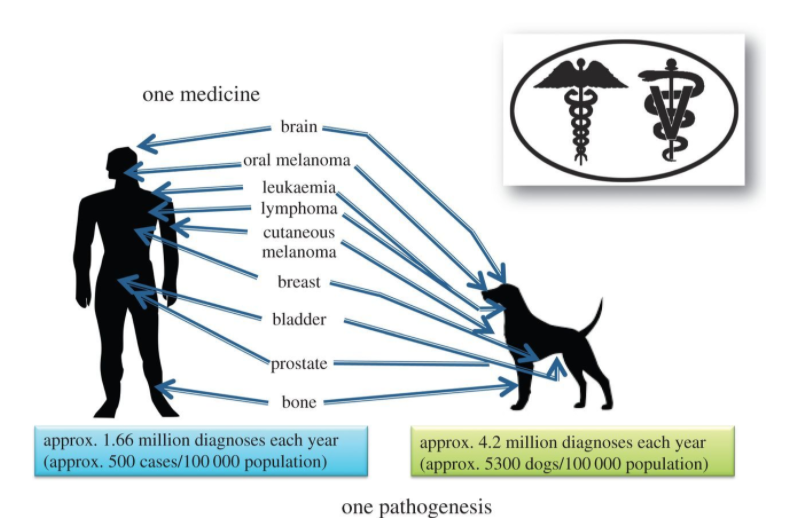| print
link to this post | email a friend Rehabilitation and Oncology29 Dec 2021 By Laurie Edge-Hughes, BScPT, MAnimSt (Animal Physio.), CAFCI, CCRT
What is the role of physiotherapy and rehabilitation in oncology? It’s actually more important that you might think! In the veterinary world, oncologic care tends to reside within the realm of the veterinary specialist centers, where chemotherapy, radiation, surgery and such are offered for treatment. Or perhaps the owner is looking for an alternative, in which case a holistic veterinarian (or team) might be consulted in regards to prescription of or advisement on homeopathics, herbal medicine, Traditional Chinese Medicine, diet alterations, or other non-traditional veterinary therapies.
Where does rehab fit in? Firstly, and clearly, it is not an alternative to either of the traditional or non-traditional treatment paths mentioned above. However, rehabilitation and physiotherapy can be important adjuncts to improve wellbeing and overall health in the veterinary (or human) cancer patient. Physiotherapy can be involved in care, management, and rehabilitation of cancer patients from diagnosis to end of life.
Physiopedia1 mentions the following as ways that physical therapists can be involved in oncology:
• Conduct ongoing assessment of the needs of this patient group and their careers, in order to apply skilled interventions, which are vital for patients’ independence, functional capacity and quality of life. • Are an essential member of the multi-disciplinary team, which is the key to successful rehabilitation and management of patients with cancer and palliative care. • The absence of physiotherapy intervention would be detrimental to patient care and the ability of the patient/family to cope with the effects of the disease or its treatment on their functional capacity and quality of life.
Furthermore, since some of the causes of cancer are areas where physiotherapists have training (diet, exercise, obesity, infections, and stress), a physiotherapist might be able to discuss lifestyle factors that could contribute to the poor health of a patient, and ways to improve upon those elements.
The rehab practitioner could be part of a team that evaluates quality of life, pain, function, and/or physical limitations as a result of therapies.1,2 Following surgery or radiation, scar tissue can be an issue.2, 3, 4 Stretches or hands on therapies can benefit in these cases. Passive range of motion of adjacent (or more distal) joints could help to prevent or address scar tissue and therapeutic exercises that do that same can provide active range of motion strategies.
There are side effects to having cancer and/or as a result of cancer treatments. Some of these can be fatigue, generalized weakness, neuropathy (affecting balance), scar tissue adhesion and joint restrictions (as mentioned above), muscle tightness, lymphedema, osteoporosis, reduced cardiovascular endurance, and/or urinary/fecal incontinence.5 Guess what? Rehab can address these issues as well!
In addition to the stretching, range of motion, and manual therapies mentioned above, physical therapy treatments can include gait or balance training, strengthening, cardiovascular rehab, lymphedema education and treatment, skin care, and pelvic floor rehab.5 What is interesting to note is that cardiovascular exercise is a recommended treatment technique FOR fatigue.3
Then there is the aspect of palliative care and pain management. I wrote a blog on this a while back - https://www.fourleg.com/Blog?b=494. There is plenty that we have to offer clients in this later stage of management and care.
Then there is the potential for some of our therapies to be helpful in the treatment of tumours. Check out this blog on laser therapy for osteosarcoma - https://www.fourleg.com/Blog?b=343 While the human field of medicine is still in the ‘cover your behind’ state when it comes to laser and cancers, animal research is pointing towards laser being beneficial at best or having no effect on a tumour at worse (in vivo studies).
All in all, oncology rehabilitation is an area that is largely untapped in veterinary medicine, but an area where we have the potential to make a big impact on the quality of life of our animal patients! If you need us for this, we’re here to help!
References: 1. Physiopedia. Oncology. https://www.physio-pedia.com/Oncology Accessed July 12, 2021. 2. Physiopedia. Oncology Physiotherapy Management. https://www.physio-pedia.com/Oncology_Physiotherapy_Management Accessed july 12, 2021. 3. Chew, Jack. #182 - Physiotherapy in Oncology - Helena Silman Cohen - Chewing It Over - 07/07/2021. https://www.linkedin.com/video/live/urn:li:ugcPost:6819226854042423296/ Accessed July 12, 2021. 4. Bob & Brad. Breast Cancer- BEST Exercises to Perform After Mastectomy-Stretches. https://www.youtube.com/watch?v=pmPzxyaVNP4 October 14, 2016. Accessed July 12, 2021. 5. UCLA Jonsson Comprehensive Cancer Center. Insights into Cancer: Physical Therapy for Recovery After Undergoing Cancer Treatments. https://www.youtube.com/watch?v=C3kn2LZL__E March 21, 2017. Accessed July 12, 2021.
|

|

